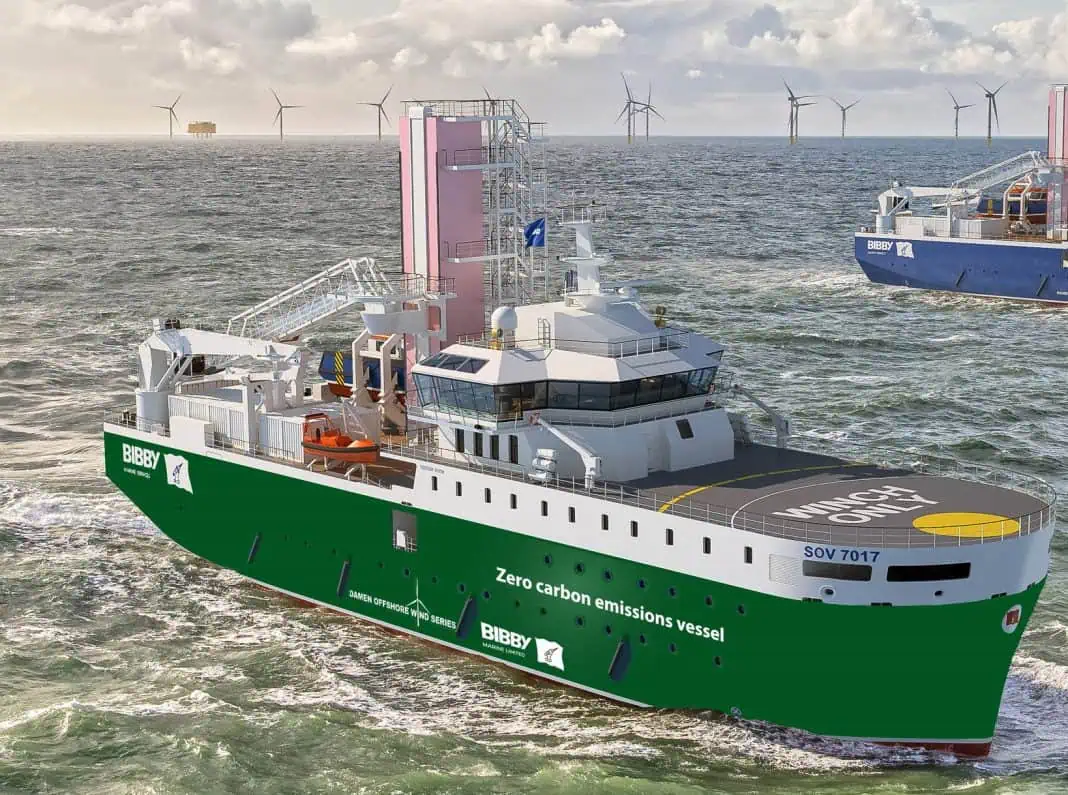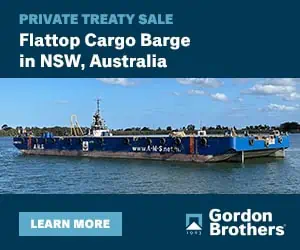ORE Catapult’s five Clean Maritime Demonstration Competition projects conclude, catalysing the journey towards offshore wind vessel decarbonisation.
The Offshore Renewable Energy (ORE) Catapult’s five Clean Maritime Demonstration Competition (CMDC) projects ended in March 2022, progressing world-leading innovations and significant strides towards wider maritime decarbonisation.
The five projects, representing £3.3m in funding from the Department for Transport and delivered in partnership with Innovate UK, helped pave the way towards a future of zero-emissions shipping with clean vessels and alternative fuels.
ORE Catapult’s flagship project of the five was a feasibility study into the development of a National Clean Maritime Demonstration Hub in Grimsby, a ‘first step’ towards the development of an infrastructure and support ecosystem built to accelerate the deployment of clean maritime technology.
Alongside nine project partners, and industry advisors including major players such as RWE and Orsted, ORE Catapult produced a high-quality feasibility study to inform a business case for infrastructure-investment in Zero-Emission Fuels/charging-infrastructure at the Port of Grimsby, the world’s largest operations and maintenance (O&M) port. It is hoped that the project will act as a catalyst to showcase Grimsby at the heart of the clean maritime sector and foster further collaboration in vessel decarbonisation within offshore wind.
The other projects involved progressing innovations in electric Crew Transfer Vessels (CTVs) through the Artemis eFoiler-CTV concept; a demonstration of a world-first electric charging point prior to real-world in-field trials; an investigation into data-led emission management; and a feasibility study on the development of an offshore wind power barge, providing vessel-to-vessel charging and battery swapping capabilities.
These projects brought together partners from the offshore wind and maritime industries, the supply chain and Government, collaborating to create a blueprint for the decarbonisation of the offshore renewables’ maritime fleet.
David Cooper, ORE Catapult’s Clean Maritime Regional Partnership Manager said: “As both a producer and user of clean fuels, the offshore wind industry can act as a first mover in the deployment of zero-emissions vessels, and act as a springboard for broader maritime decarbonisation.
The completion of the CMDC projects mark a huge milestone in the industry’s journey towards net zero and it’s fantastic to see such impressive developments made in such a short space of time. We’re thrilled to have played a convening role, pulling expertise from a range of delivery partners across all the projects, acting as a blueprint for the future of vessel decarbonisation, not only within offshore wind but across the wider maritime sector.”
Paul Cairns, Managing Director at MJR Power & Automation, added: “We’re delighted to join some of the leading players in both the offshore wind and maritime industries as part of these exciting projects. It is fantastic for MJR to play our part in several projects and support the offshore wind industry in its efforts to decarbonise.”
Leo Hambro, Commercial Director, at Tidal Transit said: “The future of offshore wind logistics has to be as green as the energy that the farms produce. To achieve this ambitious goal the CMDC has enabled the development of an offshore charger and an electric foiling CTV. Tidal Transit are delighted to have been project partners in both of these and the support provided by ORE Catapult has added significant value to each.”
Rob Stewart, Aluminium Marine Consultants, added: “We have produced a feasibility study as part of the offshore wind power barge project that helps to lay the groundwork for a zero carbon transport infrastructure for the offshore wind industry.”
The outputs produced from the original five projects are expected to form the building blocks of future clean maritime programmes within offshore wind, with the likes of MJR Power & Automation extending its electric vessel charging system trials to a real-world environment announced for later this year and the National Clean Maritime Demonstration Hub in Grimsby progressing to the next phase of deploying infrastructure. Artemis will also be looking to develop its e-foiler concept further, through the build of an offshore wind CTV based on the feasibility study on the initial project. Finally, some of the partners from the Charging and Battery Swapping Vessel project will use the feasibility study developed in this CMDC work as the foundation for a further project known as Zephyrus.
National Clean Maritime Demonstration Hub
The project will conduct a high-quality feasibility study that, informing a business case for infrastructure-investment in Zero-Emission (ZE) Fuels/charging-infrastructure at the Port of Grimsby, at the same time as investment in operational programmes of work that will establish Grimsby as a national Clean Maritime Demonstration Hub (CMDH).
Project partners include: ORE Catapult; Wood; Lloyds Register; ABP; Infrastrata (Harland & Wolff); TP Group; MJR Power & Automation; ZEM-Tech; Rix; Workboat Association.
Artemis electric eFoiler CTV
Led by Artemis Technologies and building on the work of the emerging Belfast Maritime Consortium cluster as a global centre of excellence for zero-emission maritime technology, this project brings together partners from across the whole supply chain to investigate the feasibility of the Artemis-eFoiler™ electric propulsion system as a transformative solution to decarbonise global CTV operations.
Project Partners include: Artemis Technologies; OREC; Lloyd’s Register EMEA, Tidal Transit Ltd.
Offshore wind on-turbine electrical vessel charging system
This project will design, build, and test an electric charge point situated on a wind turbine. This approach will access the infrastructure already in place (turbine platform, electrical cables) to provide renewable electricity to vessels. As an eCTV ‘docks’ with the turbine a cable reel will lower down an electrical charge connection which will plug in to the vessel and charge a battery on-board. Although the technology necessary for this is relatively mature this has yet to be done before and so this project will need to develop standards, working practices and procedures in order to safely carry this out at sea.
Project Partners include: ORE Catapult, MJR Power & Automation Ltd; OREC; Artemis Technologies; Tidal Transit; Xceco.
Data Led Emissions Management (D-LEMA)
This project builds upon proven solutions to provide an innovative approach to the analysis of vessel emissions, a sector that, to date, has lacked a clear analytic methodology. It will utilise the ION Marlin solution as a base, proven on over more than 150 global deployments, to integrate data from an existing activity database. The resulting solution will provide historical backlogged performance analytics as a baseline, as well as close to real-time performance analytics via a range of standard dashboards that will enable the port and vessel operators to review performance.
Project Partners include: ORE Catapult; Plymouth Marine Laboratory, ION
Charging and Battery Swapping Vessel
This project will complete a detailed design and operational simulation of a mothership charging vessel, hosting a number of zero-emission electric CTVs. The mothership will take the concept of in-field charging which utilizes the power generated from the wind farm to power a flexible, zero emission power swappable battery solution capable of removing diesel emissions from offshore wind Operations and Maintenance. This project represents genuine architectural and disruptive innovations and demonstrates how to de-carbonize the offshore wind sector in a cost-effective way through the use of flexible swappable batteries that reduces the cost, weight and size of investment for offshore wind operators. This disruptive approach leverages the availability of onshore charging into a system capable of functioning effectively in an offshore market.
Analysis from Aluminium Marine Consulting has suggested that if the solution is implemented, it could save over 750,000 tons of CO2 per year, as well as creating a sizeable number of new high-skilled sustainable jobs.
Project Partners include: Aluminium Marine Consulting; ORE Catapult; Turbulent Simulations Ltd; MJR Power & Automation Ltd; Jeremy Benn Associates Ltd.
CMDC
The projects above are part of the Clean Maritime Demonstration Competition, funded by the Department for Transport and delivered in partnership with Innovate UK.
Announced in March 2020, and part of the Prime Minister’s Ten Point Plan to position the UK at the forefront of green shipbuilding and maritime technology, the Clean Maritime Demonstration Competition is a £20m investment from government alongside a further c.£10m from industry to reduce emissions from the maritime sector. The programme is supporting 55 projects across the UK, including projects in Scotland, Northern Ireland and from the South West to the North East of England. As set out in the Clean Maritime Plan (2019), Government funding has been used to support early-stage research relating to clean maritime. The programme will be used to support the research, design and development of zero emission technology and infrastructure solutions for maritime and to accelerate decarbonisation in the sector.













